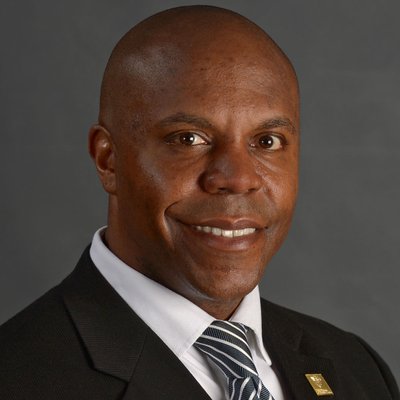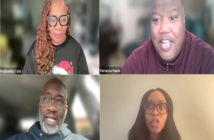By Maya Pottiger,
Word In Black
People aren’t rubber bands.
Even as kids attend school in-person full-time again and life slowly returns to normal, they aren’t going to snap back to who they were and how they felt before the COVID-19 pandemic. It had a deep and lasting impact on everyone, especially Black families and Black children, that we are still learning about, says Fitzgerald, Ph.D., EdM and MSW, an internal consultant with the National Council for Mental Wellbeing.
And one of the keys to understanding these impacts and finding solutions is acknowledging the important variables that we like to ignore, Fitzgerald says, like race, gender, and class, which all play a role in a person’s identity.
“We have to be able to take race into consideration more often as we think about solutions versus these universal solutions that we think apply to every child,” Fitzgerald said. “That does a disservice to children, and it also ignores their pain.”
Parents of K-12 students overwhelmingly agreed that the pandemic had a somewhat to very negative impact on both their children’s education (61 percent) and emotional well-being (48 percent), according to an October 2022 study by Pew Research Center.
However, while Black parents were the least likely to say the pandemic had a negative impact on their children’s emotional well-being (39 percent), they were the most likely to say the emotional impact hasn’t gotten better (30 percent).
How can both be true? In an interview with Word In Black, Fitzgerald spoke about Black folks’ history with trauma and mental health, and how we move forward from here.
Word In Black: When we’re talking about this lingering negative impact on emotional well-being, what does that look like, especially in Black students in the K-12 age range?
Terence Fitzgerald: When we think about children specifically, trauma can play out in attention span. It can play out in behaviors where you’re already within a system where you’re already being scrutinized differently. So not paying attention, maybe displaying unwanted academic behaviors.
The majority of teachers, specifically non-teachers of color, will see that behavior as, “Oh, that’s how they are. This is how they act,” and it feeds into the stereotype about people of color, especially kids of color. And when it comes to the parents’ response, it’s like, “oh, they don’t care about their kids’ education. Look how they’re responding.”
Well, they’re responding in an adaptive way due to the trauma that they’re already undergoing. So it plays out much differently. Our schools, our doctors, our institutions — any institution that deals with children already has issues with understanding trauma, so the fact that people of color, and others who don’t fit into the stereotype, display trauma differently.
WIB: Many have argued that we’ve returned to normal: kids are in school, masks have been optional for a long time. Can you explain why these negative impacts are sticking around?
Fitzgerald: Because that’s trauma. Trauma doesn’t end just because the event is no longer occurring.
For example, we can think about 9/11. Yes, this city is clean, the debris is removed, we have all of these other safety protocols put into place. That doesn’t stop the trauma that initially occurred. It’s like throwing a 50-ton boulder in a lake. Those ripples that are created continue on and on, even though where that initial boulder landed is far away. That’s trauma.
Trauma continues on, so we’re going to see the effects until someone is able to put into place measures where we’re able to say, this is what trauma is, this is how we deal with it, this is how we can help those who have these concerns. But by putting it in the rearview mirror and going, “it’s in the past” does a disservice to children because they’re still dealing with those repercussions. We know on a cellular level that trauma can change and can have an effect on one’s DNA. That’s how powerful trauma is.
WIB: Why do you think Black parents were the least likely to say the pandemic impacted their kids’ emotional well-being?
Fitzgerald: It’s important, when we look at this, to take into consideration the history of Black people, and the history of Black people and its relation to environmental stress, as we think about trauma and this prolonged trauma. So having experience with prolonged trauma as it relates to being a person of color in a system, which is rooted in oppression and marginalization, and subjugation, you become accustomed to what that looks like. It becomes nothing new to you.
If you know that racism and the fact that your life is considered less than in comparison to people who are non-people of color, specifically, White, you live with this. You grew up in this environment, what that trauma brings, and you’re reminded daily that your value is less than. Even though it doesn’t look the same as it did in the 1960s or 50s, people of color, specifically, Black and Native Americans, are consistently reminded — through policies and procedures, institutions, the media, movies, the way stories are covered, music, and daily interactions — that your value is less than, so that set of circumstances has created historical trauma, intergenerational trauma, so this is not new to people of color. It isn’t new.
WIB: The other piece of the research is that Black parents were the most likely to say emotional well-being hasn’t improved. Why is that?
Fitzgerald: If there is strife, or feelings of unsurmountable social economic changes that have created this set of circumstances for people to live in, and the emotions that people undergo with these traumatic events, it’s a harsher pain for those who are oppressed — historically oppressed.
So what White people feel as we think about COVID, and what they saw in relation to schooling, how a majority of schools were inadequate in preparation for a national pandemic, we saw how schools were ineffective in putting into place a plan. We saw the effects on the kids, to children in their learning. We still don’t know the full extent of the effect of COVID on the social and emotional well-being of children.
Now, put that into context. This is what white people are feeling: “Oh, my gosh, this is traumatic.” This is not new for people of color, to be left out, for people not to have a plan, for systems to be inadequate in addressing the needs and concerns. This isn’t new.
Maybe what the data is showing is that people of color are like, “no, this is par for the course.” And the fact that we don’t historically take in consideration mental health, and that’s a historical thing, that’s a historical fact. We think about historical research around psychology, psychiatry: people of color were left out.
If we think about the institutions that were then put into place to deal with those concerns, they didn’t offer the same services or offer any services, at times, to people of color. So if you grew up in a society where you’re seeing mental health discussed over here, but your mental health isn’t seen as a concern, people then adapt. They create their own strategies for dealing with it.
Now we’re dealing with the fact that people of color are — even more so now than I ever heard growing up — hearing these conversations about mental health and Black communities. White communities have been having this much longer. Now we’re also doing this sort of catch-up. So Black parents may not be able to recognize how that trauma may be playing out in their lives.
It’s different. Trauma plays out differently, gender-wise, cultural, ethnic, religious, or racial. It plays out differently. So when the majority of the news is covering “this is what trauma is, this is what it looks like,” and Black parents are going, “Oh, my kid isn’t doing this.” But they are displaying it — it’s just different. And we don’t talk about those differences enough, how trauma looks along racial lines.
WIB: What are some ways that parents can support their children who are still experiencing this negative impact from the pandemic?
Fitzgerald: One is to have a sense of understanding and forgiveness. Forgiveness for the fact that their children are still displaying the ramifications of undergoing trauma, as we think about COVID. To have some forgiveness in our hearts that these children are, in a sense, suffering, and it is our responsibility, then, to understand trauma. What does trauma look like? How can it affect us? How can I advocate for my child as they are displaying these particular traits of trauma? How can I support my child? How can I educate those within their lives that what you’re seeing is not what you think it is?
This isn’t a child being defiant for defiance sake. This isn’t a child who fits into your false narrative of people of color: “That’s how Black kids work or how Black kids act in schools,” but to say, wait a minute, I have to educate them to let them know this is what this is. And because of that, it will hopefully force people to confront what trauma is. It also ties into building resiliency within these children. Since I know what trauma looks like now, I’m advocating for my child.
How can I then set up my child to be more resilient? How can I build off of this strength for them to meet these challenges of what COVID had? What COVID presented? What COVID did?
Help us Continue to tell OUR Story and join the AFRO family as a member –subscribers are now members! Join here!



